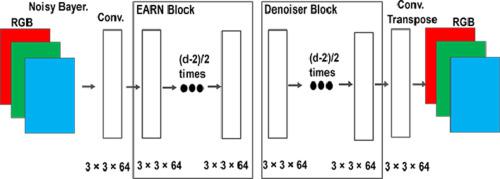当前位置:
X-MOL 学术
›
Comput. Electr. Eng.
›
论文详情
Our official English website, www.x-mol.net, welcomes your
feedback! (Note: you will need to create a separate account there.)
Smart embedded system based on demosaicking for enhancement of surveillance systems
Computers & Electrical Engineering ( IF 4.0 ) Pub Date : 2020-09-01 , DOI: 10.1016/j.compeleceng.2020.106731 Sadia Din , Anand Paul , Awais Ahmad
Computers & Electrical Engineering ( IF 4.0 ) Pub Date : 2020-09-01 , DOI: 10.1016/j.compeleceng.2020.106731 Sadia Din , Anand Paul , Awais Ahmad

|
Abstract Demosaicking and denoising are essential elements in digital photography pipelines. The use of convolutional neural networks (CNN)-based image demosaicking and denoising methods has been very successful. However, still there is a room for improvement in the network performance in terms of efficiency and accuracy. The main challenge that remains to be addressed is to guarantee the visual quality of reconstructed images, particularly in the presence of noise. To address these challenges, this paper introduces a novel demosaicking and denoising conjunct strategy using deep adaptive residual learning. The proposed framework has three stages. Initially, zero padding is performed to increase processing speed and preserve the edges of the image. In the second phase, we perform demosaicking using interpolation in order to find missing values using information about neighboring pixels. Finally, the reconstructed image is created using the original image. To evaluate the feasibility of the proposed scheme, we used Pytorch and Google Colab with 400 images for training and 100 images for validation The outcomes show that the proposed scheme beats cutting edge joint demosaicking and denoising schemes regarding both structural similarity index metrics (SSIM) and peak signal-to-noise ratio (PSNR) and basic similitude record measurements (SSIM).
中文翻译:

基于去马赛克的智能嵌入式系统增强监控系统
摘要 去马赛克和去噪是数字摄影流程中的基本要素。使用基于卷积神经网络 (CNN) 的图像去马赛克和去噪方法非常成功。然而,在效率和准确性方面,网络性能仍有提升空间。仍有待解决的主要挑战是保证重建图像的视觉质量,尤其是在存在噪声的情况下。为了应对这些挑战,本文介绍了一种使用深度自适应残差学习的新型去马赛克和去噪联合策略。拟议的框架分为三个阶段。最初,执行零填充以提高处理速度并保留图像的边缘。在第二阶段,我们使用插值执行去马赛克,以便使用有关相邻像素的信息找到缺失值。最后,使用原始图像创建重建图像。为了评估所提出方案的可行性,我们使用 Pytorch 和 Google Colab,其中 400 张图像用于训练,100 张图像用于验证 结果表明,所提出的方案在结构相似性指数指标 (SSIM) 和峰值信噪比 (PSNR) 和基本相似记录测量 (SSIM)。
更新日期:2020-09-01
中文翻译:

基于去马赛克的智能嵌入式系统增强监控系统
摘要 去马赛克和去噪是数字摄影流程中的基本要素。使用基于卷积神经网络 (CNN) 的图像去马赛克和去噪方法非常成功。然而,在效率和准确性方面,网络性能仍有提升空间。仍有待解决的主要挑战是保证重建图像的视觉质量,尤其是在存在噪声的情况下。为了应对这些挑战,本文介绍了一种使用深度自适应残差学习的新型去马赛克和去噪联合策略。拟议的框架分为三个阶段。最初,执行零填充以提高处理速度并保留图像的边缘。在第二阶段,我们使用插值执行去马赛克,以便使用有关相邻像素的信息找到缺失值。最后,使用原始图像创建重建图像。为了评估所提出方案的可行性,我们使用 Pytorch 和 Google Colab,其中 400 张图像用于训练,100 张图像用于验证 结果表明,所提出的方案在结构相似性指数指标 (SSIM) 和峰值信噪比 (PSNR) 和基本相似记录测量 (SSIM)。










































 京公网安备 11010802027423号
京公网安备 11010802027423号